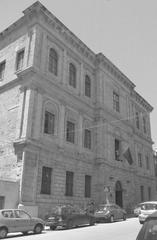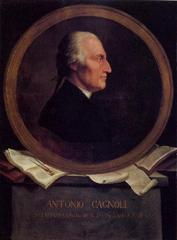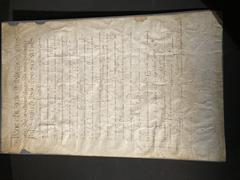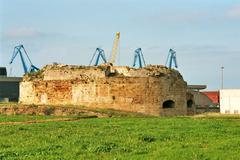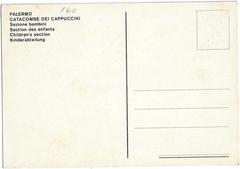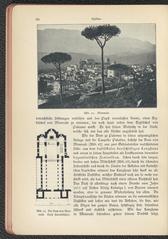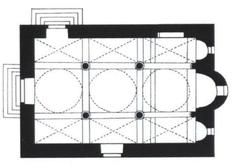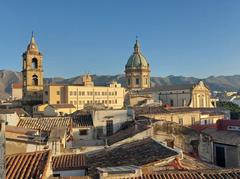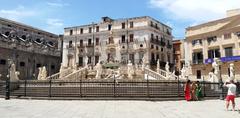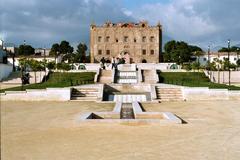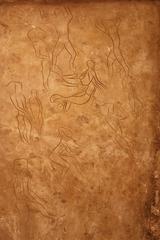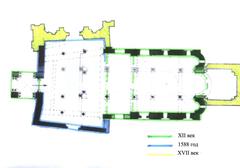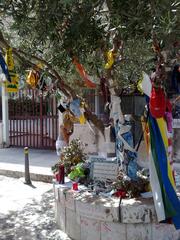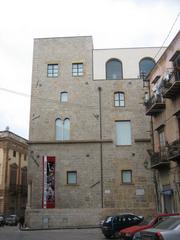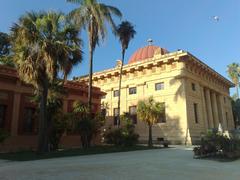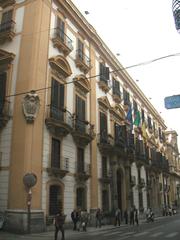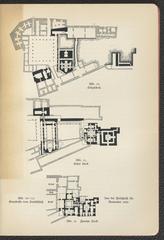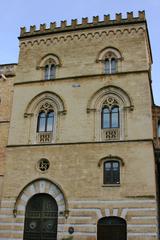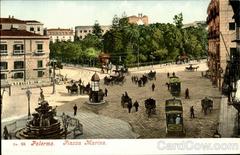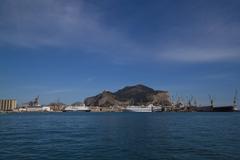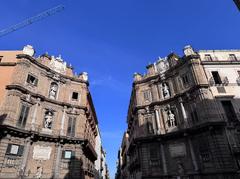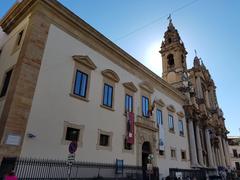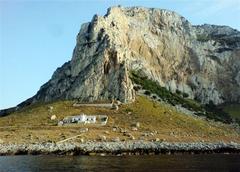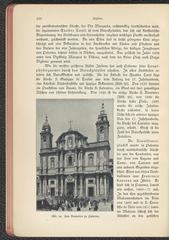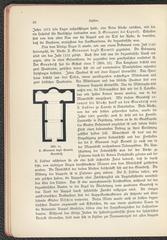Comprehensive Guide to Visiting Via del Fondaco, Palermo, Italy
Date: 24/07/2024
Introduction
Nestled in the historic heart of Palermo, Via del Fondaco is a captivating street that offers a rich tapestry of cultural and historical experiences. This thoroughfare, whose name is derived from the Arabic term ‘funduq’ meaning hotel-warehouse, has been a hub of commerce and interaction since its origins during the Arab rule in Sicily from the 9th to 11th centuries. Over time, Via del Fondaco has evolved, absorbing influences from Norman, Swabian, Renaissance, and Baroque periods, making it a living museum of Palermo’s diverse heritage (Cultured Voyages). Visitors to Via del Fondaco can explore a variety of architectural wonders, vibrant markets, and cultural landmarks that together paint a vivid picture of Palermo’s past and present (Untold Italy). This comprehensive guide aims to provide you with all the information you need for an enriching visit, including historical insights, visitor tips, and highlights of nearby attractions.
Table of Contents
- [Introduction](#introductionintroduction)
- [Discover the Rich History and Cultural Significance of Via del Fondaco in Palermo](#discover-the-rich-history-and-cultural-significance-of-via-del-fondaco-in-palermodiscover-the-rich-history-and-cultural-significance-of-via-del-fondaco-in-palermo)
- [Introduction](#introductionintroduction-1)
- [Historical Background](#historical-backgroundhistorical-background)
- [Origins and Early History](#origins-and-early-historyorigins-and-early-history)
- [Medieval Period](#medieval-periodmedieval-period)
- [Influence of Norman and Swabian Rule](#influence-of-norman-and-swabian-ruleinfluence-of-norman-and-swabian-rule)
- [Renaissance and Baroque Periods](#renaissance-and-baroque-periodsrenaissance-and-baroque-periods)
- [19th and 20th Centuries](#19th-and-20th-centuries19th-and-20th-centuries)
- [Modern-Day Significance](#modern-day-significancemodern-day-significance)
- [Architectural Highlights](#architectural-highlightsarchitectural-highlights)
- [Palazzo Conte Federico](#palazzo-conte-federicopalazzo-conte-federico)
- [Church of Saint Ignazio all’Olivella](#church-of-saint-ignazio-allolivellachurch-of-saint-ignazio-allolivella)
- [Cultural and Social Impact](#cultural-and-social-impactcultural-and-social-impact)
- [Visitor Information](#visitor-informationvisitor-information)
- [Nearby Attractions](#nearby-attractionsnearby-attractions)
- [Special Events and Guided Tours](#special-events-and-guided-toursspecial-events-and-guided-tours)
- [Photographic Spots](#photographic-spotsphotographic-spots)
- [Preservation and Future Prospects](#preservation-and-future-prospectspreservation-and-future-prospects)
- [FAQ](#faqfaq)
- [Complete Guide to Visiting Palazzo dei Normanni in Via del Fondaco, Palermo - Tips, Tickets, and More](#complete-guide-to-visiting-palazzo-dei-normanni-in-via-del-fondaco-palermo---tips-tickets-and-morecomplete-guide-to-visiting-palazzo-dei-normanni-in-via-del-fondaco-palermo---tips-tickets-and-more)
- [Getting There](#getting-theregetting-there)
- [Best Time to Visit](#best-time-to-visitbest-time-to-visit)
- [Visiting Hours and Tickets](#visiting-hours-and-ticketsvisiting-hours-and-tickets)
- [What to Wear](#what-to-wearwhat-to-wear)
- [Local Etiquette](#local-etiquettelocal-etiquette)
- [Safety Tips](#safety-tipssafety-tips)
- [Language](#languagelanguage)
- [Currency and Payments](#currency-and-paymentscurrency-and-payments)
- [Dining and Drinking](#dining-and-drinkingdining-and-drinking)
- [Shopping](#shoppingshopping)
- [Nearby Attractions](#nearby-attractionsnearby-attractions-1)
- [Guided Tours](#guided-toursguided-tours)
- [Accessibility](#accessibilityaccessibility)
- [Photography](#photographyphotography)
- [Emergency Contacts](#emergency-contactsemergency-contacts)
- [FAQ](#faqfaq-1)
- [Exploring Via del Fondaco in Palermo - History, Attractions, and Visitor Tips](#exploring-via-del-fondaco-in-palermo---history-attractions-and-visitor-tipsexploring-via-del-fondaco-in-palermo---history-attractions-and-visitor-tips)
- [Introduction](#introductionintroduction-2)
- [Historical Significance](#historical-significancehistorical-significance)
- [Architectural Highlights](#architectural-highlightsarchitectural-highlights-1)
- [Palazzo dei Normanni](#palazzo-dei-normannipalazzo-dei-normanni)
- [Quattro Canti](#quattro-cantiquattro-canti)
- [Cultural Experiences](#cultural-experiencescultural-experiences)
- [Vucciria Market](#vucciria-marketvucciria-market)
- [Teatro Massimo](#teatro-massimoteatro-massimo)
- [Museums and Galleries](#museums-and-galleriesmuseums-and-galleries)
- [Regional Archaeological Museum Antonio Salinas](#regional-archaeological-museum-antonio-salinasregional-archaeological-museum-antonio-salinas)
- [Stanze al Genio](#stanze-al-geniostanze-al-genio)
- [Culinary Delights](#culinary-delightsculinary-delights)
- [Local Cuisine](#local-cuisinelocal-cuisine)
- [Fine Dining](#fine-diningfine-dining)
- [Practical Tips for Visitors](#practical-tips-for-visitorspractical-tips-for-visitors)
- [Best Time to Visit](#best-time-to-visitbest-time-to-visit-1)
- [Getting Around](#getting-aroundgetting-around)
- [Safety and Etiquette](#safety-and-etiquettesafety-and-etiquette)
- [Nearby Attractions](#nearby-attractionsnearby-attractions-2)
- [FAQ](#faqfaq-2)
- [Conclusion](#conclusionconclusion)
- [References](#referencesreferences)
Discover the Rich History and Cultural Significance of Via del Fondaco in Palermo
Introduction
Via del Fondaco, located in the historic center of Palermo, Italy, is a street that offers a journey through time. From its origins during the Arab rule to its modern-day significance, this street reflects the rich cultural tapestry of Palermo. Whether you’re a history enthusiast or a casual visitor, Via del Fondaco promises an enriching experience that you won’t soon forget.
Historical Background
Origins and Early History
The term “fondaco” itself is derived from the Arabic word “funduq,” which means hotel-warehouse. This etymology reflects the street’s historical role as a hub for merchants and traders. The concept of the fondaco was introduced to Sicily during the Arab rule, which lasted from the 9th to the 11th centuries. This period saw the establishment of various commercial centers that facilitated trade between the East and the West.
Medieval Period
During the medieval period, Via del Fondaco became a crucial part of Palermo’s commercial network. The street was strategically located near the port, making it an ideal spot for merchants to store their goods and conduct business. The fondaco buildings typically had a dual purpose: the ground floor served as a warehouse, while the upper floors provided lodging for the merchants. This setup was similar to the Fondaco dei Tedeschi in Venice, which also combined residential and commercial functions.
Influence of Norman and Swabian Rule
The Norman conquest of Sicily in the 11th century brought significant changes to Palermo, including Via del Fondaco. The Normans, under Roger I, integrated the existing Arab infrastructure into their own administrative and commercial systems. This period saw the construction of several palaces and churches, many of which were influenced by Arab-Norman architecture.
Following the Normans, the Swabian dynasty, led by Emperor Frederick II, further enhanced Palermo’s status as a cultural and economic center. Frederick II was known for his patronage of the arts and sciences, and his reign saw the flourishing of various cultural institutions. Via del Fondaco, with its strategic location and commercial importance, played a significant role in this cultural renaissance.
Renaissance and Baroque Periods
The Renaissance and Baroque periods brought about further transformations to Via del Fondaco. The street witnessed the construction of several grand palaces and buildings, reflecting the architectural styles of the time. One notable example is the Palazzo Conte Federico, which showcases a blend of Arab-Norman and Baroque elements. This palace, located near Via del Fondaco, is a testament to the street’s historical significance and its role in Palermo’s architectural heritage.
19th and 20th Centuries
The 19th and 20th centuries were periods of significant change for Palermo and Via del Fondaco. The unification of Italy in the 19th century brought about modernization and urban development. However, this period also saw the decline of some of the older commercial centers, including Via del Fondaco. The street’s historical buildings suffered from neglect and decay, reflecting the broader socio-economic challenges faced by Palermo.
The 20th century, particularly the post-World War II era, saw efforts to revive and preserve Palermo’s historic center. Initiatives were undertaken to restore the architectural heritage of streets like Via del Fondaco. These efforts aimed to balance modernization with the preservation of historical and cultural landmarks.
Modern-Day Significance
Today, Via del Fondaco stands as a symbol of Palermo’s rich and diverse history. The street is part of the Albergheria district, one of the four historic quarters of Palermo. This district is known for its vibrant markets, historic buildings, and cultural diversity. The nearby Ballarò Market, for instance, is a bustling marketplace that has been in operation for centuries, reflecting the enduring commercial spirit of the area.
Architectural Highlights
Via del Fondaco is home to several architectural gems that reflect its historical significance. The street features a mix of Arab-Norman, Renaissance, and Baroque styles, showcasing the diverse influences that have shaped Palermo over the centuries. Notable buildings include:
-
Palazzo Conte Federico: This palace is a prime example of the architectural fusion that characterizes Palermo. It features elements from different historical periods, including a 12th-century Arab-Norman tower and 18th-century Baroque frescoes. The palace is open for tours, offering visitors a glimpse into Palermo’s rich architectural heritage (source).
-
Church of Saint Ignazio all’Olivella: Located near Via del Fondaco, this church is part of the Olivella district, known for its vibrant nightlife and cultural attractions. The church itself is an architectural marvel, featuring a blend of Baroque and Renaissance elements (source).
Cultural and Social Impact
Via del Fondaco has not only been a commercial hub but also a cultural melting pot. The street has witnessed the confluence of various cultures, including Arab, Norman, Swabian, and Spanish influences. This cultural diversity is reflected in the street’s architecture, cuisine, and social fabric.
The street’s proximity to the Ballarò Market further enhances its cultural significance. The market is a microcosm of Palermo’s multicultural heritage, offering a variety of goods ranging from fresh produce to traditional Sicilian delicacies. The vibrant atmosphere of the market, with its colorful stalls and lively interactions, provides a unique cultural experience for visitors.
Visitor Information
-
Visiting Hours: Via del Fondaco is accessible 24/7. However, individual attractions like the Palazzo Conte Federico may have specific visiting hours. It’s advisable to check the official websites of these sites for the most accurate information.
-
Tickets: Entry to the street itself is free, but some attractions like the Palazzo Conte Federico may charge an admission fee. Ticket prices typically range from €5 to €15.
-
Accessibility: The street is pedestrian-friendly, but some historical buildings may have limited accessibility due to their age and structure.
-
Travel Tips: Consider taking a guided tour to fully appreciate the historical and cultural significance of the street. Many tours offer insights into the architectural and social history of the area.
Nearby Attractions
-
Ballarò Market: A bustling marketplace that has been in operation for centuries, offering a variety of goods ranging from fresh produce to traditional Sicilian delicacies.
-
Palazzo Conte Federico: A prime example of Palermo’s architectural fusion, featuring elements from different historical periods.
-
Church of Saint Ignazio all’Olivella: An architectural marvel featuring a blend of Baroque and Renaissance elements.
Special Events and Guided Tours
Palermo hosts various events throughout the year, celebrating its diverse cultural traditions. Check for any cultural events or festivals taking place in the area. Guided tours are highly recommended to gain deeper insights into the historical and cultural significance of Via del Fondaco.
Photographic Spots
Via del Fondaco offers numerous photographic opportunities, from its historical buildings to the vibrant Ballarò Market. Capture the essence of Palermo’s rich heritage through your lens.
Preservation and Future Prospects
Efforts to preserve and revitalize Via del Fondaco are ongoing. Various initiatives aim to restore the street’s historical buildings and promote its cultural heritage. These efforts are part of broader urban regeneration projects aimed at revitalizing Palermo’s historic center.
One notable project is the restoration of the Palazzo Butera, a grand palace located near Via del Fondaco. The restoration project, led by Francesca Frua de Angeli and Massimo Valsecchi, aims to transform the palace into a cultural and artistic hub. Such initiatives reflect a growing recognition of the importance of preserving Palermo’s architectural and cultural heritage.
FAQ
-
What are the visiting hours for Via del Fondaco?
- Via del Fondaco is accessible 24/7. However, individual attractions like the Palazzo Conte Federico may have specific visiting hours.
-
How much do tickets cost?
- Entry to the street itself is free, but some attractions may charge an admission fee, typically ranging from €5 to €15.
-
Is Via del Fondaco accessible?
- The street is pedestrian-friendly, but some historical buildings may have limited accessibility.
Complete Guide to Visiting Palazzo dei Normanni in Via del Fondaco, Palermo - Tips, Tickets, and More
Getting There
Via del Fondaco is located in the heart of Palermo, making it easily accessible by various modes of transportation. If you are staying in the city center, walking is a convenient option. For those coming from further afield, Palermo’s public transportation system, including buses and trams, can get you close to Via del Fondaco. The nearest bus stop is just a short walk away, and you can use the AMAT bus service, which is reliable and frequent. For more information on bus routes and schedules, visit the AMAT Palermo website.
Best Time to Visit
Palermo enjoys a Mediterranean climate, making it a year-round destination. However, the best time to visit Palazzo dei Normanni in Via del Fondaco is during the spring (April to June) and fall (September to October) when the weather is mild and pleasant. During these months, you can avoid the peak summer heat and the crowds that flock to Palermo in July and August. Early mornings and late afternoons are ideal times to explore the area, as the light is perfect for photography and the streets are less crowded.
Visiting Hours and Tickets
Palazzo dei Normanni, also known as the Norman Palace, is one of Palermo’s most significant historical sites. The palace is open to visitors from Monday to Saturday, 8:15 AM to 5:40 PM, and on Sundays and holidays, from 8:15 AM to 1:00 PM. Tickets can be purchased on-site or online. General admission is €10, with discounted rates available for students and seniors. Guided tours are available for an additional fee and provide in-depth insights into the history and architecture of the palace. For more details, visit the official website.
What to Wear
Comfortable walking shoes are a must when visiting Palazzo dei Normanni, as the streets are cobblestoned and can be uneven. Lightweight, breathable clothing is recommended, especially during the warmer months. Don’t forget to bring a hat, sunglasses, and sunscreen to protect yourself from the sun. In the cooler months, a light jacket or sweater will suffice.
Local Etiquette
Palermo is known for its warm and welcoming locals, but it’s always good to be aware of local customs and etiquette. When greeting someone, a friendly “Buongiorno” (Good morning) or “Buonasera” (Good evening) goes a long way. It’s also customary to greet people with a kiss on both cheeks, even if you are meeting them for the first time. When visiting churches or religious sites, dress modestly and be respectful of the local customs.
Safety Tips
Palermo is generally safe for tourists, but like any major city, it’s important to stay vigilant. Keep an eye on your belongings, especially in crowded areas, and be cautious of pickpockets. Avoid walking alone in poorly lit areas at night, and stick to well-populated streets. If you need assistance, don’t hesitate to ask the local police or shopkeepers, who are usually very helpful.
Language
While Italian is the official language, many locals in Palermo speak Sicilian, a distinct dialect. English is not widely spoken, especially among the older generation, so it’s helpful to learn a few basic Italian phrases. Carrying a phrasebook or using a translation app can also be beneficial.
Currency and Payments
Italy uses the Euro (€), and it’s advisable to carry some cash, as smaller shops and markets may not accept credit cards. ATMs are widely available, and most major credit cards are accepted in hotels, restaurants, and larger stores. Tipping is not mandatory in Italy, but it’s appreciated. A small tip of 5-10% is customary in restaurants if the service is good.
Dining and Drinking
Palermo is famous for its street food, and Via del Fondaco is no exception. Don’t miss the chance to try local specialties like arancini (fried rice balls), panelle (chickpea fritters), and sfincione (Sicilian pizza). For a sit-down meal, there are numerous trattorias and osterias offering delicious Sicilian cuisine. When dining out, it’s common to order multiple courses, including antipasti (starters), primi (first course, usually pasta), secondi (main course, usually meat or fish), and dolci (desserts). For a unique experience, visit the nearby Ballarò Market where you can sample a variety of local foods and soak in the vibrant atmosphere.
Shopping
Via del Fondaco is home to several artisan shops and boutiques where you can find unique souvenirs and gifts. Look for locally made products such as ceramics, jewelry, and textiles. The nearby Vucciria Market is also worth a visit for its lively atmosphere and wide range of goods, from fresh produce to handmade crafts.
Nearby Attractions
While exploring Via del Fondaco, take the time to visit some of Palermo’sother top attractions, many of which are within walking distance. The Palermo Cathedral is a must-see, with its stunning blend of architectural styles. The Palatine Chapel is another highlight, known for its exquisite mosaics and rich history. For a more relaxed experience, head to the Foro Italico, a picturesque waterfront promenade perfect for a leisurely stroll.
Guided Tours
To make the most of your visit, consider joining a guided tour. There are several options available, including walking tours, food tours, and historical tours. A guided tour can provide valuable insights into the history and culture of Palazzo dei Normanni and Palermo as a whole. For a unique experience, try a hidden gems walking tour, which will take you off the beaten path to discover lesser-known sites and stories.
Accessibility
Palermo is working towards becoming more accessible for all visitors, but it’s important to note that some areas, including Via del Fondaco, may have limited accessibility due to the historic nature of the streets and buildings. If you have mobility issues, it’s advisable to check in advance with your accommodation and tour providers to ensure they can accommodate your needs. Many major attractions offer accessibility information on their websites.
Photography
Via del Fondaco offers plenty of photo opportunities, from its charming streets to its historic buildings. Early morning and late afternoon provide the best lighting for photography. Be respectful when taking photos of people, and always ask for permission before photographing locals, especially in markets and religious sites.
Emergency Contacts
In case of an emergency, the following numbers are important to have on hand:
- Police: 112
- Ambulance: 118
- Fire Department: 115
It’s also a good idea to have the contact information for your country’s embassy or consulate in Palermo.
FAQ
Q: What are the opening hours of Palazzo dei Normanni? A: The palace is open from Monday to Saturday, 8:15 AM to 5:40 PM, and on Sundays and holidays, from 8:15 AM to 1:00 PM.
Q: How much do tickets cost to visit Palazzo dei Normanni? A: General admission is €10, with discounted rates available for students and seniors. Guided tours are available for an additional fee.
Q: Are there guided tours available at Palazzo dei Normanni? A: Yes, guided tours are available and provide in-depth insights into the history and architecture of the palace. Check the official website for more details.
Q: What is the best time of year to visit Palermo and Palazzo dei Normanni? A: The best time to visit is during the spring (April to June) and fall (September to October) when the weather is mild and pleasant.
Call to Action
For more tips and guides on visiting Palermo, download our mobile app, check out our other related posts, and follow us on social media for the latest updates. Enjoy your visit to Palazzo dei Normanni and the beautiful city of Palermo!
Exploring Via del Fondaco in Palermo - History, Attractions, and Visitor Tips
Introduction
Via del Fondaco, located in the heart of Palermo, Italy, is a street steeped in history and cultural significance. From its origins as a commercial hub during the Arab and Norman conquests to its present-day charm, Via del Fondaco offers a unique blend of historical landmarks, architectural wonders, and vibrant local culture. In this guide, we’ll explore what to see and do on Via del Fondaco, including key attractions, cultural experiences, and practical tips for visitors.
Historical Significance
Via del Fondaco is a street rich in history, reflecting the diverse cultural influences that have shaped Palermo over centuries. The term ‘fondaco’ itself is derived from the Arabic word ‘funduq,’ meaning a house-warehouse, indicating the area’s historical role as a commercial hub. This street was once a bustling center for merchants, particularly during the time of the Arab and Norman conquests. The fondachi were essential for trade, serving as both storage facilities and lodging for foreign merchants. This dual function helped facilitate the exchange of goods and cultures, making Palermo a melting pot of influences from across the Mediterranean and beyond.
Architectural Highlights
Palazzo dei Normanni
One of the most significant landmarks near Via del Fondaco is the Palazzo dei Normanni, also known as the Royal Palace of Palermo. This palace is a stunning example of Norman architecture blended with Arab influences. Originally built in the 9th century, it was later expanded by the Normans in the 12th century. The palace houses the Palatine Chapel, renowned for its exquisite mosaics and intricate wooden ceiling. The palace is open to visitors from Tuesday to Sunday, and tickets cost around 12 euros per person. More details can be found on the official website.
Quattro Canti
Another architectural gem is the Quattro Canti, or Piazza Vigliena, located at the intersection of Via Maqueda and Via Vittorio Emanuele. This Baroque square, constructed in 1609, features four corner buildings adorned with statues representing the four seasons, Spanish kings, and patron saints of Palermo. The square is a perfect spot for photography and offers a glimpse into the city’s Baroque past. For more information, visit Untold Italy.
Cultural Experiences
Vucciria Market
A visit to Via del Fondaco would be incomplete without exploring the Vucciria Market. This historic market is a sensory overload, offering everything from fresh produce to local delicacies. The market is particularly famous for its street food, including panelle (chickpea fritters) and arancini (stuffed rice balls). The market operates daily, but the best time to visit is in the morning when the vendors are most active. For a detailed guide, check out Capture the Atlas.
Teatro Massimo
For those interested in the performing arts, the Teatro Massimo is a must-visit. Located a short walk from Via del Fondaco, this opera house is the largest in Italy and the third largest in Europe. It offers a variety of performances, including opera, ballet, and concerts. Guided tours are available for around 10 euros, providing insights into the theater’s history and architecture. More information can be found on Untold Italy.
Museums and Galleries
Regional Archaeological Museum Antonio Salinas
The Regional Archaeological Museum Antonio Salinas is one of the most important museums in Italy, housing an extensive collection of ancient artifacts. Located near Via del Fondaco, the museum features exhibits ranging from prehistoric times to the Roman era. Highlights include the Palermo Stone, an ancient Egyptian artifact, and various Greek and Roman sculptures. The museum is open from Tuesday to Sunday, and admission costs around 6 euros. For more details, visit Capture the Atlas.
Stanze al Genio
Art enthusiasts should not miss the Stanze al Genio, a unique museum dedicated to Sicilian maiolica tiles. The museum is housed in a private apartment and features over 5,000 tiles dating back to the 15th century. Visits are by appointment only, and admission costs 10 euros. The vibrant colors and intricate designs of the tiles offer a fascinating glimpse into Sicilian art and craftsmanship. More information can be found on Untold Italy.
Culinary Delights
Local Cuisine
Palermo is renowned for its culinary diversity, and Via del Fondaco is no exception. The area is dotted with trattorias and street food stalls offering a variety of local dishes. Must-try items include pasta con le sarde (pasta with sardines), involtini alla palermitana (Palermo-style rolls), and cannoli (a sweet pastry filled with ricotta cheese). For a comprehensive food tour, consider booking a guided experience through Capture the Atlas.
Fine Dining
For those seeking a more upscale dining experience, there are several fine dining options near Via del Fondaco. Restaurants like Osteria dei Vespri and Bye Bye Blues offer gourmet Sicilian cuisine paired with an extensive wine list. These establishments focus on using locally sourced ingredients to create innovative dishes that reflect the rich culinary heritage of Palermo. Reservations are recommended, especially during peak tourist seasons.
Practical Tips for Visitors
Best Time to Visit
The best time to visit Palermo is during the spring (April to June) and fall (September to November) when the weather is mild, and the tourist crowds are smaller. Summers can be hot and humid, while winters are generally mild but can be rainy. For more tips on planning your visit, check out Italian Trip Abroad.
Getting Around
Public transport in Palermo includes buses and trams, but the most convenient way to explore the city is on foot, especially in the historic center. Taxis are available but can be expensive. For those planning to explore beyond the city, renting a car is advisable. More information on transportation options can be found on Condé Nast Traveller.
Safety and Etiquette
Palermo is generally safe for tourists, but it’s always wise to stay vigilant, especially in crowded areas like markets. Pickpocketing can be an issue, so keep your belongings secure. When visiting religious sites, dress modestly, covering shoulders and knees. Tipping is appreciated but not mandatory; rounding up the bill or leaving a small amount is customary.
Nearby Attractions
Cefalù
If you have extra time, consider taking a day trip to Cefalù, a picturesque beach town located about an hour’s drive from Palermo. Known for its stunning coastline and historic cathedral, Cefalù offers a relaxing escape from the hustle and bustle of the city. The town is particularly beautiful in the summer, making it an ideal spot for enjoying the authentic Dolce Vita lifestyle. More details can be found on Salt in Our Hair.
Monreale
Another worthwhile excursion is to Monreale, famous for its magnificent cathedral adorned with golden mosaics. The town is located just a short drive from Palermo and offers breathtaking views of the Conca d’Oro valley. The cathedral is a UNESCO World Heritage site and a masterpiece of Norman architecture. For more information, visit Cultured Voyages.
FAQ
Q: What are the visiting hours for Via del Fondaco?
A: While Via del Fondaco itself is a public street and can be visited at any time, specific attractions like the Palazzo dei Normanni and the Regional Archaeological Museum have set visiting hours. Check their official websites for the most current information.
Q: How much do tickets cost for attractions on Via del Fondaco?
A: Ticket prices vary by attraction. For example, entry to the Palazzo dei Normanni costs around 12 euros, while the Regional Archaeological Museum charges approximately 6 euros. Always verify prices on the official websites before your visit.
Q: What are some historical sites near Via del Fondaco in Palermo?
A: Notable historical sites include the Palazzo dei Normanni, Quattro Canti, and the Regional Archaeological Museum Antonio Salinas. Each offers a unique glimpse into Palermo’s rich history.
Call to Action
Ready to explore Via del Fondaco and its myriad attractions? Download our mobile app Audiala for personalized travel guides, check out our other related posts for more travel inspiration, and follow us on social media for the latest updates and tips.
Conclusion
Via del Fondaco in Palermo stands as a testament to the city’s rich and multifaceted history. From its origins as a commercial hub under Arab rule to its current status as a cultural and historical landmark, the street encapsulates the essence of Palermo’s diverse heritage. The area is not only a treasure trove of architectural marvels like Palazzo Conte Federico and the Church of Saint Ignazio all’Olivella but also a vibrant cultural melting pot, especially evident in the nearby Ballarò Market (Capture the Atlas). Efforts to preserve and revitalize this historic street continue, ensuring that it remains a vital part of Palermo’s urban landscape. Whether you’re a history enthusiast, a culture lover, or simply a curious traveler, Via del Fondaco offers an experience that is both deeply educational and immensely enjoyable. For more information and updates, consider downloading our mobile app Audiala and following us on social media.
References
- Cultured Voyages, 2024, Via del Fondaco and Palermo source url
- Untold Italy, 2024, Things to do in Palermo source url
- Capture the Atlas, 2024, Things to do in Palermo source url
- Italian Trip Abroad, 2024, One Day in Palermo Itinerary source url
- Salt in Our Hair, 2024, Palermo Sicily source url
- Condé Nast Traveller, 2024, Travel Guide Palermo source url
- Lovely Terra, 2024, Palermo Travel Guide source url
- This Way to Italy, 2024, Best Things to Do in Palermo Italy source url
- Federicosecondo.org, 2024, Palazzo dei Normanni source url
- Palermoballaro.org, 2024, Albergheria District source url
